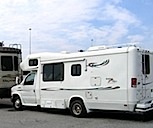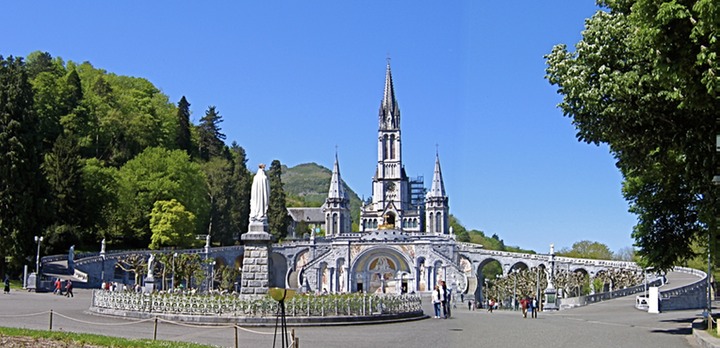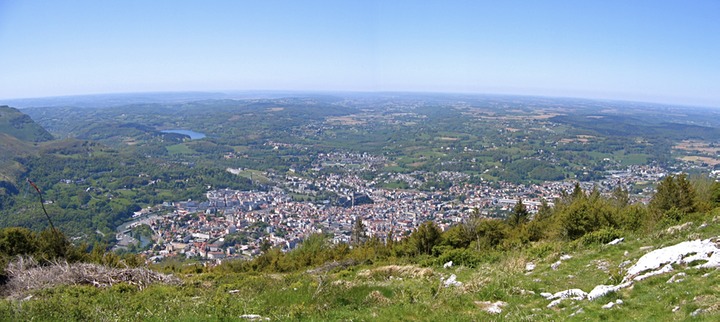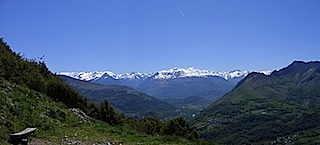2009 Weblog
Entry 18--Final Accounting
We drove 5247 miles through The Netherlands, Belgium, France, Italy, Switzerland, and Germany and back through France, Belgium and The Netherlands. We spent $2887 on gas, averaging $6.50 per gallon for 444 gallons. We never filled the tank to test the gas mileage, but we had picked Rover up with little gas in the tank and dropped her off the same way, so we figure that an average of 11.8 mpg was pretty accurate. With very few exceptions, David drives no more than 55 mph, even on the autobahn.
We stayed 85 nights in Europe, 8 of them at free camperstops. The other 77 nights we paid an average of $26, which included showers and electricity. The most expensive was in Paris at $45/night. Campground expenses were $2078.
We made a conscious decision to eat out more often this year--3 or 4 times a week at least--so our food costs were higher (and our food experiences more fun) at $3434. It is necessary to pay for the privilege of sitting at an outdoor cafe, so a simple coffee or glass of wine for both of us can easily cost $8 -10. That was often necessary just to find a place to get off our feet and to gain the right to use the bathroom. However, once you have made a purchase, you can sit as long as you like--you will not be asked to move on. Our wine expenses probably averaged €2-3 a day. We had some pretty good cheap wines!
Our additional transportation costs were $1350, very close to the $100 a week we had expected for bus, trams, trains, and tolls. It is slightly higher primarily because of our one-day excursion to London on the EuroStar. Train fare for the two of us was $400.
Our insurance cost $1325 for three months. Rover is uninsured in storage. As far as we can discover, there is only one company that will insure American-registered motorhomes in Europe, and it offers no reduction for long-term storage. Our storage costs until next April are $875, prepaid. We were also able to get a $400 refund on our car insurance because it wasn’t being driven for 3 months.
Direct expenses for Rover were $1208. This includes our new air compressor for the tires, battery work, the work done by the storage people last winter, the oil change and brake check, and various things we added like the laundry rack, rugs, and water hose adaptors.
We paid $142 in ATM and foreign money transaction fees. Our current bank had wanted to charge 3%, so instead we kept open a checking account at our old bank that charges only a 1% fee. We paid all our bills and other financial work on the internet and didn’t come home to a single thing we had forgotten to deal with.
Museums and tours cost $850, but many of our best memories were free: the sand dune at Arcachon, the Pont du Gard, the ride into Italy, all the cathedrals and outdoor markets. Our little 30-hour excursion to London was $700 for train, hotel and play tickets. (Susan thinks this constitutes David’s birthday and Christmas presents, while David thinks the matter is negotiable.)
Of course we spent additional monies on airfare, gifts, t-shirts, internet acccess ($76), newspapers ($136), LP gas ($55), and miscellaneous stuff. But we basically stayed within our anticipated $1000/weekly expenses. We don’t think anyone could duplicate that level of spending while staying in hotels, eating all meals in restaurants and paying travel expenses, and renting an RV in Europe would cost at least $1000 a week.
Entry 17--July 2
On our way back to Amsterdam we stopped for two nights in Ghent, Belgium. The campground is part of a huge sporting complex, with playing fields, a stadium, and parks, and would have been easy to get to if the signs had been less ambiguous. But instead we took a little side trip through the busy city streets. When we arrived, we found that the park was in the middle of a two-day soccer tournament. We were warned it could be noisy well into the night and it was, even through we were in a separate site for motorhomes.
Ghent was a very nice surprise. The bus picked us up right at the campground and we got off on the bridge from which, according to all the guide books, you have the best view of the old city (they were right). The bridge overlooked a busy riverside where a crowd was listening to a string quartet playing from a small boat. Later we joined them and listened to selections played on a grand piano, also on a small boat. Both the summer sales and the beautiful weather had brought out lots of people. There is quite a bit to see in Ghent and we decided to save some of it for another trip, as we can easily pass through this way again.


We wanted to visit Brussels but had read that it is not motorhome friendly--there is no campground nearby with easy access to the city and no dedicated motorhome parking--so we investigated taking a train. They run every half hour and cost only $25 for two day-return tickets. So on Sunday morning we got up early and took the bus to the train station, waited about 10 minutes and took the train to Brussels, about a 30-minute trip. The old part of Brussels is totally charming and just as bustling as so many of the other cities we’ve visited. We ate in the old city square, walked all over and took a bus tour that got us out into the European Union section and away from the city center. We shopped in a few lace and chocolate shops and then hopped on another train and returned to Ghent. The whole thing was much easier than moving Rover; best of all, the soccer players had gone home by then so we had a quiet night.
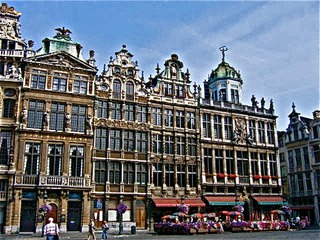

We hadn’t been happy with our batteries’ behavior, and David had located a battery dealer who sold our brand of sealed gel batteries, so on our way to Amsterdam we took a little detour to the city of Waalwijk in the Netherlands to talk to him. Our batteries have a history: they were brand new in 2007 when we lost our first motorhome in a flood. We salvaged them, and when we purchased the current Rover, we had them tested and recharged. They were still fully charged when we picked up Rover from five months of storage in April, but discovered that although they recharge adequately, they also lose their charge very quickly. As a result, we have been limiting ourselves to places where we could plug in almost every night. Sure enough, the initial tests of the dealer in Waalwijk were not favorable, so we decided to leave the battries with him for more complete attempts at regeneration. If these work, we will pick up the batteries next year; if they need to be replaced, we will purchase new ones from the dealer then.
So we drove off to Amsterdam without batteries, thinking we would be okay there because we could plug in. (The more electrically literate among you will sense where this is going.) But without batteries there is no source of 12-volt power: true, the charger/converter goes 110-to-12, but only to the batteries, not to the 12-volt loads like the water pump. We had not realized this. And even the refrigerator, which uses propane or 110-volt power, needs 12-volt DC for its control panel and propane ignition. We were prepared to do without some things, but we wanted to have refrigeration and needed to have the water pump in order to winterize Rover for storage, and neither would work without the batteries. So we ended up driving out of the campground in Amsterdam to an auto supply store, where we purchased a single 12-volt battery for the three nights we were in Amsterdam.
But once again, it wasn’t that simple. We placed the battery in the tray right at the store and immediately saw that the cable leads would not fit the battery’s larger diameter posts. So we had to buy adaptors to reduce their size. What’s more, when we got back to the campground and tried to hook up the battery, we found we had only two posts (of course) instead of four to accommodate the seven or eight leads dangling like giant strands of spaghetti in our battery compartment. And when David managed to get everything attached, he could not push the tray back in without everything coming undone. So for the last three nights we simply left the battery tray sticking out. Eventually everything worked out, but at no little expense and trouble.
While in Amsterdam, we spent the better part of a morning trying to find a pack-and-ship kind of shop because one of our window shades had come unstrung and Susan had hoped to ship both of them back to the manufacturer for restringing. We were referred to the post office but discovered they will not ship anything over 39” in length. So we gave up on that idea and, even though we were trying to avoid it, will have to restring them ourselves when we return next year. We spent much of the rest of the sunny day taking a canal tour in the city. The next day we cleaned Rover inside and out, packed for storage and packed for home. It was a good thing we accomplished so much because we found out later in the day that the airline had moved our flight time up and we had very little time available to complete our winterizing the next day.
Rover is now in storage awaiting our return next year. It has been an amazing three months and we feel truly blessed to have been able to experience it all safely and in good health. We promise one more blog entry after we have returned home and totalled our mileage and various categories of expenses.
We are delighted that several of our readers have expressed interest in doing what we are doing: we had hoped that this blog would have that effect. We understand the economy is having an effect on the shipping rates. Now may just be the time to go for it. We’d love to see you in a campground next year.
Entry 16--June 26
Our campground in Verdun was probably the best one so far. It had everthing we needed, including free and good internet access and a wide paved boulevard that made it very easy to get into and out of our site. It was about a 20 minute walk into the town. Verdun is a small, quite depressed town, despite an energetic riverside open space with stores and cafes. Yachts and houseboats tied up along the quay, which had been built as a gift from Great Britain after WWI. But apart from this space and a few side streets, the city center looked like it could use some cleaning, paint and repair. Still, it was drawing many tourists to its war memorials and museums.
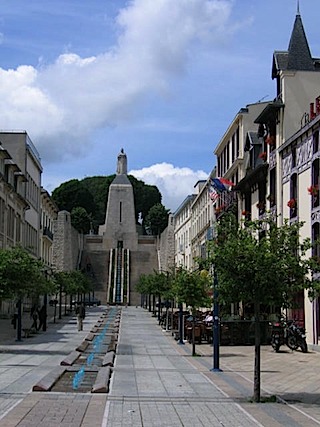
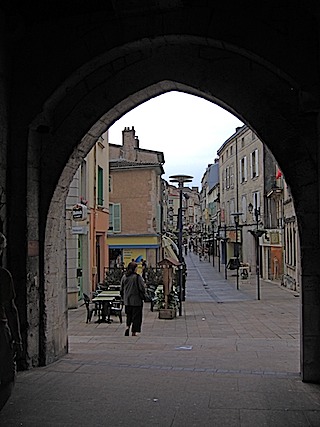
We took the four-hour tour to four locations about 10 miles outside the city. The tour guide spoke a little English and took the time to explain briefly what we were seeing. Much of the battlefield area is now forested: originally it had been farm land but was bombed so heavily during the 300 days of the Battle of Verdun that 90 years later the landscape remains pockmarked and scarred. Nine villages were completely destroyed and not rebuilt because they were too dangerous to enter, and much of the surrounding area remains off limits because of the possibility of unexploded ordinance. We visited an underground fort, water dripping on our heads, which 3000 men had occupied during the battle, first French, then German, then French again. One room was walled off because 900 German soldiers, victims of an explosion, were buried there.
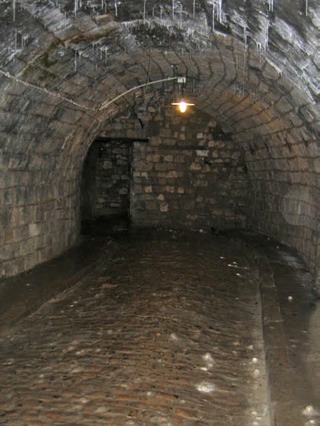

Then we went to the Ossuary. In front, 15,000 French soldiers are buried, while the Ossuary itself holds the remains of 130,000 (yes, that’s right--one hundred thirty thousand) unidentified French and German soldiers. The building is like a huge granite temple the length of two football fields. But the strangest thing is that you can go out to the back side and look in small windows and see the bones of these men. Bones piled upon bones.
The next day we visited the town’s underground citadel that has been turned into a tourist attraction. It had housed up to 10,000 men as they prepared to go to the front lines. It now features a little electric car, like a fun house ride, that drives you through a series of scenes explaning how the soldiers lived there and on the front. We now know more about WWI than we ever learned in any history class. It was all quite an experience.
We drove on to Rheims where we had a camperstop just off the motorway in mind. We were hoping to find it and park and then either leave the city after visiting the cathedral or stay for the night if it proved to be a safe place. We (and our GPS) were unprepared for the volume of detours and road construction that we were confronted with in the city.


But we finally prevailed: we toured the city and their remarkable cathedral and stayed the night. We were safely tucked behind a youth hostel with another motorhome in a parklike setting. It is not unusual for youth hostels to offer free camper services and overnight parking if they have space.
While in Verdun, we had decided to take a major detour, so on Sunday we drove to Paris, which we had been planning to avoid. We were going to leave Rover in the campground and take the EuroStar through the Chunnel to London just for one night so we could see “Arcadia,” a play by Tom Stoppard. (Our former students--hi to you all--will understand the impetus behind this decision.) But first we had to get through Paris traffic to the campground. Because this was on a Sunday, we thought traffic might be lighter and it was . . . until we reached the park that we had to go through to get to the campground. Everyone in Paris was at the park, nearly all of them with a car. Cars lined every street and were parked down the center of the streets so that we could barely make it through. In addition, we tried to follow the campground signs but found some of the roads were blocked off because there was a huge outdoor concert about a half mile from the campground (we heard it until midnight). Even the police couldn’t tell us how to get through, so it was a good thing we had been there last year and knew where we had to keep heading. It was a great relief to finally get to the campground and find they had room for us because they had not responded to our email request for a reservation.
The next day we took the bus to the metro, on which you can get anywhere in Paris--that is, if you can get to a Metro station. Even the bus had trouble getting through the traffic. It took us 20 minutes to go 2/3 of the way around a large traffic circle to the Metro stop. Then we walked our legs off around Paris, scouted out the train station, picked up our tickets, and spoke with an old man who sold David a Tour de France tshirt and claimed to be very sure Lance Armstrong would win again.
Tuesday we locked Rover up tight, took the train to London (just over 2 hours, with security just like at an airport)--saw the play (wonderful)--stayed at our favorite hotel--went to our favorite Starbucks--saw the Monets at the National Gallery--walked through the gift shop at the British Museum--and took the train back to Paris, just in time for the evening rush hour on the subway and bus back to the campground. Thursday we took a different and slightly less busy route out of Paris, where we took only one wrong turn that eventually got us on a very good road.
We are now headed north with only one week to go. We have started to think about how we are going to get Rover cleaned up and get everything packed away. We can’t just drive it into our driveway and unload everything. So we are trying to eat up what we have, keep clean the things we will leave behind, and decide just what goes home with us besides a suitcase full of dirty clothing. Tonight we are staying south of Calais right on the English Channel. There is only a low sand dune between us and the water. It is strange to think that a few days ago we were on a train going under it. Tonight we watched ferries pass and dock at Calais. Maybe someday we’ll put Rover on one and see if we can drive on the left side of the road.

Entry 15--June 18
Sometimes in this life we receive gifts that we don’t expect and can probably never repay. One such was the wonderful gift of hospitality we were given this past weekend. We had been been corresponding with a couple living in Germany who found our blog and are interested in doing what we are doing, but the other way around: in the US and possibly in a Born Free. They had invited us to stop by if we were ever in the neighborhood and offered irresistible extras: free unlimited use of their American-sized washer and dryer and the internet. Once we had decided to visit we also asked if they knew of a mechanic who could handle something Rover’s size. Skip, a retired US Air Force pilot, responded to the challenge and not only found a master mechanic but also purchased the oil filter and the brake fluid we might need.
So on Saturday Skip and his wife Marianne welcomed us into their home with genuine hospitality, took us to church on Sunday, fed us good German food, wine and beer, and talked travel, motorhomes, and lots of other things for hours. On Monday Rover had her oil changed and brakes checked and, because of a very heavy rain, even got a little bit of a bath. She cleared the mechanic’s garage door with a good 4 inches to spare.
While she was being serviced, Skip gave us a quick tour of the countryside on single lane back roads and hills we would never have attempted with Rover. One village had a 25% grade on part of the street through the town. (When we say “quick” tour, think AF pilot, narrow winding roads, and nimble car.) By the time we left on Tuesday after one more cup of good strong German coffee we were old friends. We have been invited back whenever we come through again and we hope to be able to return the favor in Minnesota some day. We are blessed.
We drove back into France to camp by the River Moselle in Metz, another city with a municipal campground just a few blocks from everything. Metz’s cathedral may have a higher ratio of glass-to-stone than anything else we’ve seen, and the windows, including some by modern artists like Marc Chagall, are spectacular.
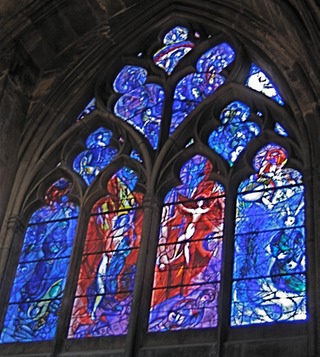
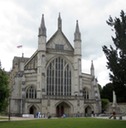
We find it interesting that when things like windows and altars need to be replaced in these 800-year-old buildings, the new ones don’t try to look “period.” Metz is also home to a new art center, Centre Pompidou-Metz: it’s in the same spirit as the one in Paris, but even more outrageous. However, we were disappointed to discover that its opening is years behind schedule. Because of the campground’s great location, we hope to return to Metz when the art center has opened: perhaps it will be ready in 2010, although clearly it has quite a ways to go.
Metz’s campground did have two shortcomings, however: to get water flowing in the shower you have to keep pushing a button, and we were unable to take on any fresh water because none of the fittings would work with our hose. This is the first time this has happened in our nearly five months of touring in Europe. So today we purchased four different hose adaptors to ensure that won’t happen again.
We looked at the map and wanted to head downstream to Nancy, but there is no urban campground there, so instead we decided to stay another night in Metz and took a train to Nancy for the day. We had to wait longer for the train than it took to get there (about 35 minutes). Then we walked all over and took a mini train tour when we got tired of walking. Nancy’s claim to fame is its huge central square surrounded by seven very similar ornate stone 18th-century public buildings with six black and golden gates and one Arc de Triumph leading into (or out of) the square.

It is named after Stanislas, the beneficent leader who is responsible for nearly everything of value in the city, from hospitals, university, parks and old folks homes to schools and libraries. It is a beautiful, totally over the top space. Then we took the train back to Metz and a bus to the market near the campground.
Our next bit of sightseeing will take on a different form because we are now in Verdun (where our water hose fit without any attachments). This is the location of one of the longest and deadliest battles in WWI. The four-hour tour we are taking tomorrow will be in French, so we picked up some reading material. We have homework to do tonight. We don’t expect it will be pleasant.
Entry 14--June 12
We are amazed that hundreds of European campers don’t die of e-coli bacteria every year. We are very careful where and how we get water: we have dedicated fresh water hoses that are not used for anything else. But we regularly find people filling their fresh water tanks from the water hose provided at dump sites. True, these hoses are provided for filling fresh water tanks, but they are also used for rinsing dump sites and are left lying on the ground. We cringe when we see it.
The water we get has been consistently excellent, but getting it is often a bit of a challenge. We have been in only three campgrounds where water was available at each camp pitch. Generally there is a central water supply somewhere with a hose, and then there are usually additional water faucets around the campgrounds, often the push-button type that allow a litre or two at a time. Many of the faucets have no threading, and we frequently have to remove or add something in order to fasten our hose. We also had to purchase an attachment at one campground and haven’t used it since.
We also looked into buying an additional hose in France but discovered that all new hoses are sold without fittings on the ends: those are purchased separately and vary widely. So we gave up on that idea. Besides, they were frightfully expensive. At campgrounds, most people use the hose provided or get their water a litre at a time. One in a while we will find non-potable water--there was a lot of that in the campground in Italy--so we simply used none of their water. Fortunately we had arrived with our fresh water tank full.
We spent a couple of mostly rainy days in the city of Belfort, where a citadel overlooks the city, guarded by a massive stone lion created by the designer of the Statue of Liberty.

Rover in the shadow of the citadel
We stumbled upon what the town proudly claims is the biggest antique market in Eastern France. Even in the light rain it drew a big crowd. Market sellers work really hard for their money, setting up and repacking everything, whether it is antiques, clothing, vegetables or fish. Then they move on to another town the next day. Every town has a market day, and they are usually all over and done by 1 PM. We usually don’t buy too much in markets unless we are returning to Rover quite quickly and easily, because we would be carrying things around with us too much.
We continued on to Basel, Switzerland, returning to a campground we had visited last fall. (Here they tried to steer us to the fresh water hose that was located at the dump site and weren’t too happy when David instead got out the pliers and tapped the water supply by the reception office.) Basel is fun and easy to visit with its great transportation system. Last time we discovered a huge Monet exhibit at one of the two chief museums, and this time we hit on a Van Gogh landscape exhibit at the other: 70 paintings borrowed from public and private collections around the world. It was quite a show and was drawing a big crowd. We were glad we found out about it early as we had to buy time-specific (and expensive) entrance tickets for the following day. And then it rained on us, but we were able to take shelter in a Starbucks--Basel is only the third city we've visited this years that has them.
Then it was on to Freiburg, Germany, on the edge of the Black Forest region. The small campground where we stayed was on a terraced hillside under many trees. The owner runs up the hill with each unit as it comes in and helps to get it sited in its tight spot. Since the next day was going to be a holiday (Corpus Christi Day, of all things), he expected the campground could be crowded. Rover has never been tucked so neatly into a site. Two little permanent camping trailers were very close to us, one behind and one next to us, but neither had occupants while we were there. We rode our bikes into the city center and discovered literally hundreds of others biking. This is a university city and it seemed that all the students had bikes. It was a challenge trying to avoid bikes, trams, and cars on some streets. In the center of the old city there were fewer cars and many busy pedestrians streets: the challenge there was to avoid the town's centuries' old water-delivery system, yet another lawsuit-waiting-to-happen.
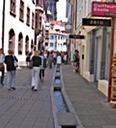
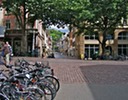
Bikes in the foreground...the middle ground...and the background
Again, no sign of any economic problems on the streets of Freiburg. And again we were having intermittent rain but it didn’t slow us down or keep us from the Munsterplatz, the Rathaus, or still another funicular that went only half way up the big hill. And once again we took refuge in still another Starbucks (this one right next to a Subway and a Burger King and just down the street from a McDonalds.) The rose gardens were in full bloom and the city is well kept and really very beautiful. The only problem is that we can’t understand anything and it makes us realize just how good our French is, at least by comparison to German.
While many campgrounds have restaurants that are really snack bars, the one in Freiburg had a real restaurant and beer garden right next door. It was doing a great business with large portions of reasonably priced meals. We ate there both nights, which is very unusual for us. The food was great: true, Susan did end up with batter fried mushrooms in “Knoblauch” (garlic) sauce one night, but they were pretty tasty.
We have ventured a bit further east into the Black Forest region: there are lots of high hills, pine trees, spectacular views and very twisty roads. This really is gorgeous country. The houses in the area are huge compared to France.

We stopped twice: once in an 800 year old town that looked too new and cute to us and once at the tallest waterfall in Germany. It is not a single free falling waterfall but a series of falls over rocks so that you can not see all of it at any one place. But it is tucked into the rock forest hill and it was a lovely cool walk to the overlooking bridge sites.
Today is the day we forgot to recharge our camera’s batteries so we will have very few pictures of the Black Forest and none of the falls. We arrived at our campground destination in the hills to find it is closed. But we were able to dump our tanks and are parked in their large parking lot, which is filling with motorhomes as the day goes on. We intend to just dry camp here tonight rather than face more winding roads today.
Entry 13--June 6
This is the 65th anniversary of D-Day. Many of the French cities we’ve visited have had a street called “(Day) (Month) 1944” or “1945,” subtitled “Day of Liberation of (that city).” These streets and squares, as well as the omnipresent War Memorials on village greens and in churches, are a constant reminder of the place that warfare holds in this country's official memory.
We have been heading vaguely north and east in the general direction of Switzerland and Germany. We spent two nights in Beaune in a campground right outside the old city walls. It was such a tight site that we had to pull into a neighbor’s pitch to back into ours. Most of the sites themselves were plenty big, but all were surrounded by high hedges, and it was a real effort to get Rover situated. For some reason three-quarters of the people there were from The Netherlands and almost all of them have trailers. One of the Dutch couples we’d talked with had told us there is very high tax on motorhomes, so most of them pull little camping trailers.
In Beaune we visited a hospital museum with a ward and kitchens as they were 300 years ago. The donors had spared no expense, and it is a beautiful building.


We also went on a wine tasting tour (15 different wines!) in the catacombs of an ancient church (dust, cobwebs, shelves of aging wine) that is now used as a winery sales room. This is the Cote D’Or region of France--Grand Cru country--which as far as we can tell means “really expensive bottles of wine.” The next day we drove past one chateau after another, each one home to a different vineyard, on our way to Dijon.

We love to find campgrounds that give us easy access to the big cities. The one is Dijon was easy to get to and right by a river walk and park. The bus that stopped out front every ten minutes brought us into the city center in just a few minutes. It couldn’t have been easier. Dijon is yet another lovely old city with its own Notre Dame church, this one with a facade containing three rows of leering gargoyles. A free minibus circles the main squares and attractions so it was very easy to navigate. We ate lunch at one of the many outdoor cafes. Lunches are cheaper than dinners, but they can still be huge. We often choose to eat lunch instead of dinner at a restaurant when we are in a city all day: for one thing, it gives us a place to sit down; for another, we are often too tired at the end of the day to go out to dinner. It doesn’t help that most restaurants don’t open to serve dinner until after 7 PM.

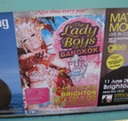
Our next stop was Salins les Bains, known for its hot baths and salt mines. Unfortunately we had to settle for the cold pool at the campground because it is necessary to make an appointment at the baths weeks in advance. Many are used as medical treatments paid by the national health system. So we took long walks through the town, including a steep climb up to the little church above the village. There were also forts on top of two very high rocky hills on both sides of the town, but the only way to get to them is by walking paths, so we avoided both. It was hard enough just to get up to the church.
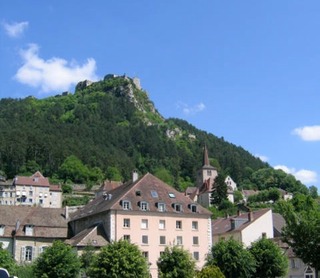
We have had very little trouble getting in to interesting sights on this trip, but the next day made up for it. We had driven a short distance through rolling farmland and forests to Besancon, where the manager of the campground let us in but said he wouldn’t be back to check us in until 3 PM. Since it was 11 in the morning, we decided to site Rover and find our own way into town because there was supposed to be a bus. Sure enough, the bus stop was nearby, but the bus came only once an hour. So we started to walk towards town, hoping to find another choice. We walked almost entirely uphill for a couple of miles before we saw another bus stop; finally we made it into town . . . just in time for everything to be closed during the crazy two-hour lunch break everyone takes. We decided to head for the major tourist attraction in the city--the Citadel--which, of course, is high on a hill overlooking the city. It was quite a climb, first along city streets and then up steps and paths. When we finally paid our €s for admission to the citadel and went through the gates, we discovered that we still had another quarter mile to climb inside the walls. It is a huge place and a great view from the top, which we would have enjoyed more if we hadn’t been so hot, tired, sweaty and thirsty. So the first thing we did was to have lunch; then we visited three little museums distributed randomly among the buildings in the citadel, as well as a very powerful French Resistance and Deportation museum. Then, of course, we got to walk all the way back down to the city again. Back on level ground, we figured out that the bus that serviced the campground didn’t come all the way into the city: instead we had to take another bus--standing room only--to a transfer point. Sometimes we think we spend a good part of each day trying to figure out how to get into and out of places either with Rover or on buses and trams. All in all, it was an uphill day in more ways than one: we enjoyed our last visit to Besancon more--that had been in 2004, when we watched Lance Armstrong win the time trial in the Tour de France.
We have spent some time making a couple of repairs. One of the sofas had come loose from the floor, so we needed some hardware to fix it. That took a trip to the French equivalent of Menards--there are a number of options, called Brico Depot, Mr Brico, or Brico Mart--this one leading to yet another parking lot adventure. And Susan spent a pleasant (insert some “pardon my French” here) afternoon temporarily fixing a broken window shade cord (many Born Free owners will understand the reference). And today it has been rainy, followed by wind, sun and more rain. Rover’s right side got really wet, so after the rain finished we went out and wiped her down and tried to wash the rest as well. Campgrounds never seem to allow campers to wash their vehicles, so it is really hard to keep Rover looking clean. We cannot complain about the rain: it is the first we have had in three weeks. What we could complain about--but won't--is the fact that changes in the exchange rate mean we have been losing 10 cents on every € in the last couple of weeks; what’s more, gas has become hard to find for less than € 1.30/liter ($5/gallon).
Entry 12--May 29
It can be expensive to travel on toll roads in Italy and France: for instance, $30 for 115 miles to Italy. So David decided we could spend more time on the “red roads” on the map and “Why don’t we see a little more of the coast while we are here?” So we took the red coast road toward St Tropez. (It just happened that our trip coincided with the Cannes Film Festival and the Formula One Grand Prix in Monaco, so we had decided to avoid both places.) Once you are on the red coast road to St Tropez, there is no way to get off it. It consists of a little time spent along beaches and lots of time hanging off rocky red cliff edges. Every inch that can be developed is built up with houses, hotels and restaurants. There was a lot of traffic and many, many bicycles on this narrow, winding, hilly stretch of road. It was certainly beautiful, but it turned out to be thirty miles of white knuckle driving. Once we met a bus on a sharp corner. We were right up against rock wall on our right and we had to back up a few feet and pull in our left mirror to let the bus pass. Fortunately we were on the rocky cliff side all the way and not the straight-drop-to-the-sea side.

We stayed overnight in St Maxime, close enough to ride our bikes to the beautiful crowded sandy beach. This time we actually swam in the sea because the weather was close to 100 degrees. This little tourist town was hosting an Italian art fair right at the beach. Then on Sunday we headed north to escape some of the heat. Fortunately it cools down into the 60’s at night and we are very comfortable in Rover. Campgrounds are getting busier and we have been to a couple that have had their pools open. This is still considered low season, so not all the facilities are open at every site.
We spent one night at the Roman Theatre campground in Vaison la Romaine (it was full but they fit us into a parking place made for a tiny French car next to an unrented cabin). This old town is built up around Roman ruins of a terribly over-restored theatre and the excavated ruins of houses and shops dating from 50-200 B.C., so we have seen something older than the Pont du Gard. Many of the shops in town were closed on Monday, but the campground owner strongly suggested we stay on Tuesday morning for the market which “fills the town.” So on Tuesday morning we moved Rover to a “camping car” parking lot in the town and went to the market, which did, in fact, fill the town: street after street of people selling plants, vegetables and fruit, clothing, jewelry, tools, fabics--even mattresses and sewing machines. Because the market took over all the parking lots as well as the streets, cars were parked all over around the edge of the town. We were able to get very close with the special parking lot for motorhomes.Overnight parking is allowed there also but we had opted for the pool and electricity at the campground and were very glad we did.
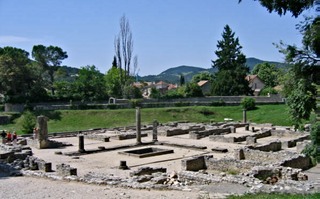
We are now in the big city of Lyon, where we’ve spent two nights and are about to spend a third. The campground is on the end of a bus line that connects to a subway that gets us into the center of town in about half an hour. Our bus ticket was also good for the funicular to the Basilica of Notre Dame that overlooks the city. This is a relatively new one built in the 1800’s and is totally over the top in sculpture and decorative painting. Walking in was another one of those “Oh, wow” moments. And purely by accident we arrived moments before the astroonomical clock rang at 3 P.M.--one of only 3-4 times of the day it rings. There were lots of people and school children wating for it to do its little multi-leveled mechanical-movement thing.
There is a sweeping panoramic view of the city from behind the cathedral. The city itself is just lovely with all its tiled roofs and wrought iron trim, with one tall, ugly, round, dark Radisson Hotel in the middle of it all. We have exhausted ourselves doing museums and took refuge in the first Starbucks we have seen since Amsterdam and also in a little sports bar where we watched two more finishes of Giro d’Italia stages.
One of the most unusual things we've seen in Lyon is a mural of several buildings painted on to the flat six story side of a building. It is so well done that (pick one):
1. you could swear you are looking down another city street (Susan's way of putting it); or
2. it's only when you get far away from it that you realize you're not looking at a real building blocking your view of some of the painted mural (David's).
Our other favorite is the Miniature Museum. There is not a doll house in sight but instead movie sets created in miniature--and several others full sized--that were used instead of real locations (think “Titanic sinking” and “White House exploding in Independence Day”). This city is also known for its puppet theatres and its silk production. The shops are full of both. It is a good thing Susan has vowed not to add to her fabric collection.
Entry 11--May 21
When we left for Arenzano, Italy, we had no idea what a spectacular ride was awaiting us. To understand this you need to know that the French Riviera, while it has beautiful beaches that go on for miles and miles, is flat and backed by foothills. In Italy, however, the mountains come right down to the sea. When we disappeared into our first tunnel on the motorway we were not prepared for what we saw upon our exit. It was one of those “Wow” moments. We exited the tunnel onto a very high bridge over a valley between two mountains. On our right we could see a city or town along the sea and on our left we could see small villages scattered on the mountainsides. We went through 65(!) tunnels that ended in bridges over valleys, each one offering a variety of incredible views of towns and the sea by the time we reached Arenzano. I have to say this was the most beautiful ride I have ever taken. I took many pictures--all of which have a piece of guard rail (for which we were very grateful) in them. But after a while I just gave up and enjoyed the views.
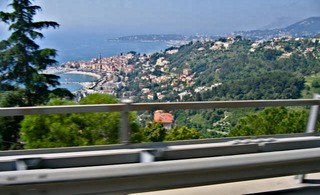

(Note from David: for the driver’s rather different perspective on all this, see the introduction to the pictures for this entry.)
We drove straight to the campground in Arenzano and got the last spot big enough for Rover, and even then our (or her) back end hung into the next site. This is a very old, well worn place with mostly permanent trailers that are here all year long. It is between a busy road and a railroad line--right on the beach. And the motorway is about 200 yards across the street and 200 feet above us. We have what they say is 3 amp service, but we tripped one circuit breaker just trying to run the refrigerator so we put that on LP gas and are using the electricity just for lights and the water pump. Fortunately we do not need the air conditioning. It has been a bright sunny 80 during the day and cools off nicely at night. And the bike race goes right past the campground.
Arenzano is a newer town. The main walking plaza on the beach is named after John F Kennedy, the finish for the race is at the Place Etati Uniti (US), and many of the buildings look relatively new. On Tuesday we walked into town (an easy 20 minute walk along the sea--and through one tunnel--to watch the preparations for the race and discovered there were practically none. There were only signs that said that all the toilets in bars and restaurants would be available to the public on Wednesday, the race day (always good information to have). On Wednesday we walked into town again to find it transformed by the Giro set up team. There were banners, barricades and roads closed everywhere, accompanied by every available policeman and woman and lots of other official looking people. We walked all over and discovered that no one had claimed the prime spot at the finish line. We hadn’t intended to do this, but we decided we’d just be sitting somewhere else for five hours, so we claimed our spot. There was No One closer to the Stage 11 finish line than we were!

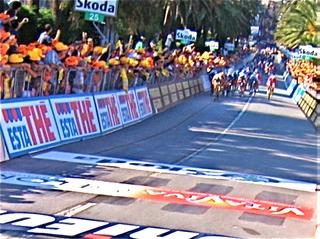
There was an older Italian man who thought it was great that an American couple cared enough to wait near him. He called David “Armstrong” because David was wearing his “Lance” t-shirt. “Hey, Armstrong, (Italian) blah blah blah.” This was translated by another young couple: ”Do you like Italians?” Now how are you going to answer that in Italy! And ”Hey, Armstrong, (Italian) blah blah blah” (“Do you like bike racing?”) “Si, I like bike racing,” so he shook David’s hand. It was great fun. It was fairly easy to claim our four square feet for the first three hours, reading the paper and eating our lunch. But it got a little crowded and pushy later. We waited in the hot sun and occasional blessed shade from the finish line banner for five hours. The race is preceded by a sponsor’s parade where the sponsors throw worthless junk like hats, balloons and keychains to the crowd. At the finish line there is a real effort to get everyone wearing a sponsor’s hat or holding something for the tv cameras. Twice someone put a hat over my Twins hat, but I just passed it back to the eager crown behind us. In a “gruppo compacto” sprinter’s finish like this one, the actual race goes by in about 5 seconds. Then there were a few stragglers, after which the workers start to pick it all up and move it on to the next stage site. It is quite an operation and quite an unusual way to spend a day. And it attracts thousands.
We had considered moving further into Italy to go to the Cinque Terra until we learned that that was the site of the next day’s race. We definitely didn’t want to drive into that mayhem along with everyone else. But because it was going to be a time trial, we decided to stay put for one more day and watch it on tv in the campground restaurant. We are getting pretty good at lounging around on the coast (and spending a minimal amount of money).
Entry 10--May 17
Some of you, like one of Susan’s geographically-challenged siblings, have suggested that we include maps so our readers can see for themselves where we are. It’s a good idea, but we haven’t been able to download a map that we can write on, so let’s do this instead:
1. Find a map of France. Actually, it doesn’t even have to be all of France--just the Mediterranean coast will do. (Already you can tell where this is going, right?)
2. Find Cannes. That’s the town with the sun and the beaches and the yachts and the film festival, where the B-grade actresses take off their clothes in front of the photographers for publicity. It’s right on the ocean.
3. Now go east a bit, staying right on the ocean, until you find Nice. There’s no film festival there, but there’s sun and beaches and yachts, and everything else you’d expect in a town called “Nice,” even if they do pronounce it “Neese” for some reason.
4. Now go halfway between Cannes and Nice. Be sure to stay right on the ocean.
That’s where we are.
What looks like low clouds are actually the Italian Alps. Oh, and it was about 80 degrees today, so we had to put the awning up to protect ourselves from the sun while we sipped our wine.
Have we mentioned that being retired is tough, but we’re determined to make it work?
We’re here because since our last entry we’ve been heading slowly toward a little town on the Italian coast called Arenzano, just west of Genoa, which is the finish line for May 20’s stage in the three-week bike race through Italy called the Giro d’Italia.
On the way to the Mediterranean coast, we visited what is probably the oldest manmade structure we’re going to see. We stopped for a night just a short walk from the Pont du Gard, a 2000 year old aqueduct built by the Romans to bring water to Nimes. Most of it still stands tall over the River Gardon, and a pedestrian bridge has been built right up against it to accommodate the large numbers of tourists. The footbridge very cleverly mimics the original in construction design and materials, so the two blend together very well. We didn’t know it wasn’t part of the original until we were almost on it. There was a large pay parking lot adjacent (which we did not have to use since Rover was at the campground), but that was the only part of the site that carried any charge. There was also no tourist information booth or anyone selling cold drinks or souvenirs, even though there was plenty of room for all of that on the long and wide approach path to the bridge. Someone is missing a golden opportunity here because there are thousands of visitors every year. We were surprised at the large number there on the day we visited.
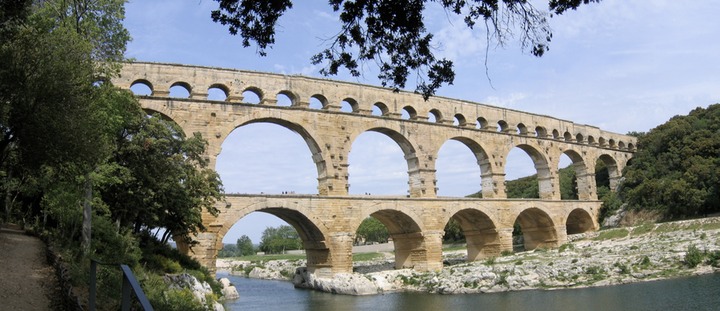
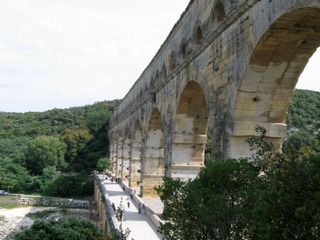
The next day we drove to Avignon, but not without incident. We had stopped at a large grocery store and checked out their gas station for access. It is one of those that has five or six pumps side by side, after which everyone drives past a pay booth at the exit. We had gotten gas and were next in line to pay before discovering that our 8’3” wide Rover (with the mirrors folded in) would not fit through their 8’2” exit lane. The only way out was to back up through the pump area and exit the way we had come in. The cashier called security, but by this time the few cars behind us had figured out what was happening and gotten around us, while David did a remarkable job of backing Rover up between the pumps, despite another car being fueled next to us. The security man arrived and waved a few cars out of our way, and we turned around and were off. It was embarrassing, but we survived, and we did not tear the awning off!
(At the risk of seeming to write about nothing but motoring hazards):
Finding a place to park in Avignon itself was nearly impossible. We managed to get ourselves into a couple of tight spots there, too, before finally seeing a sign for motorhome parking that ended up being across the river. However, it turned out to be very handy, as a free bus was provided from the large parking lot there.
Avignon was home to the popes in the 1200’s. Since we had already toured the large Palace of the Popes in 2004 when we followed the Tour de France, we took the little train ride around the old city streets and alleys. We enjoyed the ride itself more than the sights being pointed out to us, and could not believe the tight corners the driver managed to pull us through and around. We continued on to Aix-en-Provence later in the day.
We had bought a clothes drying rack because most campgrounds don’t want you to attach clotheslines to trees. (Most also do not allow campfires or even charcoal cooking fires.) At Aix we were able to do a couple of loads of laundry and dry it pretty quickly in the sunshine. The next day we took the bus to the city center. Aix was the home of Paul Cezanne, and when we went to the museum, we found it was free--for a good reason: they were in the process of setting up a Picasso/Cezanne exhibit and had most of the rooms blocked off, so we were unable to see a single painting by either of them. Ah, well--this is only the second time something like that has happened in two trips.
Aix (pronounced ex) is a beautiful city with a wide central boulevard lined with sycamores, the tree of choice in France. This boulevard was lined with cafes and restaurants spilling out on the wide sidewalks. On part of our walk we encountered a crowd of people and discovered a movie scene being filmed at one of the sidewalk cafes. Most exciting, we also found an English language bookstore that had a whole week’s worth of Herald Tribunes free for the reading. And we got to sit down for half an hour.
After two nights in Aix we drove on to revisit the little village that had captured our imagination so much on our Tour de France trip. La Cadiere d’Azur, high on a hill in Provence wine country, is yet another of France’s very old villages with tiny streets and steps masquerading as streets. It has great parking outside the village center, where we parked and walked all around (in the rain)--it isn’t very big. From the north, one can see for miles from east to west over the vineyards. It is just a lovely place and looks like it has been there for ever. But because it was raining we didn‘t try to extend our stay but instead drove on to the Mediterranean coast.


When we pick a destination out of one of our guidebooks, we are never sure just where the campgrounds will be. We usually try to find something close to city centers or on a bus line, but this time we were looking for a beach. We ended up at La Tour-Fondue on the Giens Peninsula, the southernmost point on the Cote d’Azur. We were surprised at the campground’s low €15/day price because this has to be one of the most expensive pieces of real estate we have every stayed at. The campground itself was nothing special--actually, it was a little worn looking, with some steep driveways and low trees for Rover to navigate--but we could see the Mediterranean from our window. It was a ten minute walk (in the rain again) to the ferry docks and a little rocky beach and an old fortress on the farthest point. On Saturday, when the sun was shining, we walked around again and watched the boats head out with scuba divers for the day. And we could see the islands and ships out at sea. But we stayed only one night because we are need to get closer to northwestern Italy.

And now we are between Cannes and Nice on what is certainly another expensive property. This campground’s laundry was only € 5 ($6.75) to wash and dry a load, the cheapest we have seen, so we did two loads of laundry! And then we walked the rocky beaches. We plan to come back to this place next week after seeing the stage of the bike race. It is right on a bus and train line that would make visiting Cannes, Nice and Monaco very easy, and it would be nice to just stay in one place for a while and not have to think about driving.
Entry 9--May 11
Toulouse is called the “pink city” because many of its old city center buildings are made of brick that has a distinct pinky coral color. Thanks also to the wrought iron decorative railings and the tile roofs on many of the buildings, it is a beautiful city. We toured its old cathedral and a museum housed in an equally old monastery (the building was more interesting than much of the sculpture, art and artifacts inside). The sky was trying hard to rain, but it wasn’t so bad that we couldn’t stop at an outdoor restaurant and have crepes for lunch (under a big awning.) Afterwards, there was an unusual collectors toy and book market in the city square, where people were lined up to get in. We didn’t see anything special in any of it. On the other side of the large ornate government building on the square is the Wilson Place, a lovely little garden park in the middle of a traffic circle. We are still trying to figure out who “President Thomas Wilson” was--that was the name on every plaque in the area.
After two nights in Toulouse we drove to Albi, a town we’d never heard of--we were relying on the guide book’s high recommendation. We found a campground close to the city center and--we could hardly believe it--right next to not one but two grocery stores, despite its quiet, green park-like setting. It was about a half hour walk to the center of Albi, which turned out to be a great delight: large clean open plazas with fountains and lots of people. And the sunshine probably helped, too.
Of the places we’d known nothing about before seeing them, the cathedral at Albi has been the most impressive so far. The Lonely Planet guide does a great job of introducing it: in the south of medieval France, a group called the Cathars believed some heretical things (the Albigensian heresies); one of these--their big mistake--was a rejection of worldly Rome; the Pope took offense and preached a Crusade against them; so between 1208 and 1321 thousands of them were killed by the armies of princes from northern France, who were happy to expand their influence southward with the Church’s blessing; and in the newly conquered territories the invaders erected huge new churches “to impress and subdue.”
One of these was the Cathedral Ste-Cecile at Albi, and its exterior certainly does make a threatening statement.
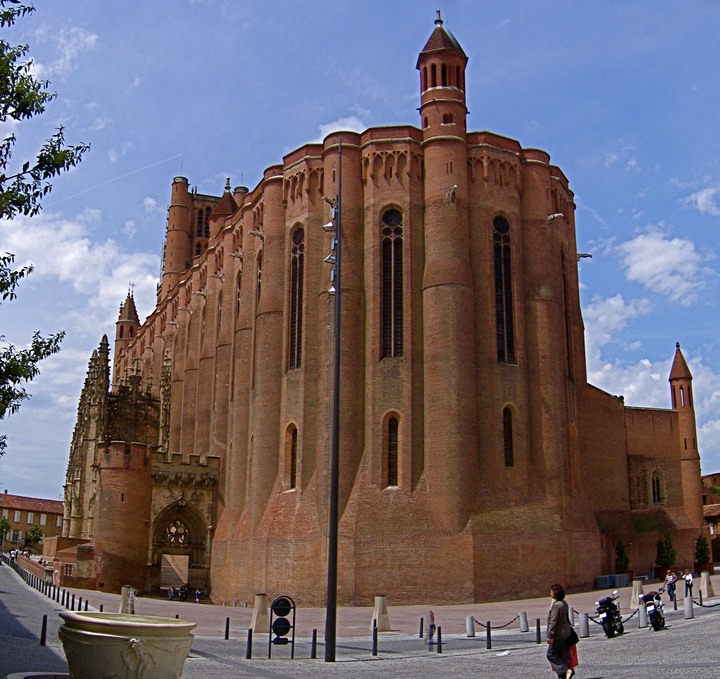
Lonely Planet: “Its sheer mass rises over town like some Tolkienesque dark lord’s tower.”
But that effect is only half the story: when you step inside, the contrast with the sinister exterior is amazing. In the early 1500s a whole troupe of Italian Renaissance artists had descended on the place, not leaving until they had painted the entire interior, one chapel after another . . . and, of course, the ceiling, too.

And if that’s not enough, Ste. Cecilia herself looks like a Pre-Raphaelite maiden:

Walking back to the city square in Albi, we stopped at a sports bar to watch the end of the first stage of the Giro d'Italia, the three-week bike race around Italy. We were told, with some heat, that no bar in town would tune in to such a thing on a day when Toulouse was playing an important Rugby League match (not soccer, mind you: rugby).
On Sunday we drove to Carcassonne and spent the afternoon doing laundry and hoping it wouldn’t rain. The drive had been a little scary because of very strong winds, but this time the red roads on the maps turned out to be very good ones, which helped somewhat.
The campground in Carcassonne is a short walk from the walled medieval city. At night the walls are illuminated, and we can see them from Rover. It looks like a fairy tale setting. In the morning we made an easy walk along a pretty little creek to the city. The old fortress which was originally the city is completely surrounded by walls and turreted towers, with access through only three gates. One of them even has a drawbridge. But when we finally got to the front gate, the first thing we saw was a car coming out the drawbridge entrance!


A new city has grown up around the old walled one, which has become totally a tourist trap--but a very lovely one. Its beginnings date back to the 12th century. Much was added to the fortifications in the 16th and 17th centuries, and major restoration work was done in the mid 1800’s while retaining the 17th century style. We toured the castle and walked every street. Every second building is a cafe or restaurant, and the ones between them are souvenir shops. But it was all still quite charming, even in the wind, which has remained strong.
It’s interesting that although we have been in many incredible places of worship, and quite a few simple ones, too, we have been unable to go to a church service. Like good ecumenical Lutherans, we’d not even insist that it be a Protestant service, but no dice. In fact, we didn’t even see a Protestant church until we’d arrived in Toulouse, but even that one didn’t list a worship schedule. In fact, only the big cathedrals have had a schedule that is regular: the small ones we’ve been near haven’t had services while we are around.
This campground in Carcassonne has free unlimited internet access so we were finally able to update this blog. Every McDonalds in France seems to have free WiFi, and we rely on them for our everyday email, baseball scores and news, but half the time the connection in the restaurant won’t let us publish our blog. And since we do not carry the computer with us all the time, we sometimes have a hard time finding a place that will let us upload.
In this campground we met a man from Denmark who spent six months riding his motorcycle around 28 US states. He got there by riding it across Russia, Siberia, and Mongolia before shipping it from Korea to British Columbia. Then he rode up to Alaska before coming back down to the rest of the US. Right now he is walking through France with a tent on his back. And people think we are adventurous!
Entry 8--May 8
One night we watch the sun set over the Atlantic Ocean; the next, over the Pyrenees. Being retired is tough work, but we do what we can.
From the dune we drove through miles of flat mashy land, through managed forests, to Bayonne, where we parked for the night in a beautiful free camperstop overlooking the ocean. There must have been fifty motorhomes there, but it was a quiet and peaceful place to stop for the night. We keep looking for other American motorhomes but so far haven’t seen any. We caught a bus for a brief tour of Bayonne--a lovely old colorful city--but mostly enjoyed the beach area.
The next day we drove to Pau (rhymes with “so,” the guidebook assures us), where we found a huge centrally located parking lot that was also supposed to be a camperstop. We spent the afternoon exploring the city and a restored chateau which, for some reason, wasn’t charging admission for the day. This is the place where France’s King Henri IV was born, and it includes the huge tortoise shell that was supposed to have been his cradle. (Henri appears to hold a place in the approved versions of French history similar to George Washington in US history and Elizabeth I in English.)
We decided we didn’t like the idea of a busy urban parking lot for an overnight stay and instead drove on to a tiny hillside campground outside of Lourdes with a distant view of the mountains. This is the first place that we have tripped a circuit breaker: we believe it’s because we had 3 amp service, which wasn’t enough when David tried to check the tire pressure with our new compressor, which draws 7 amps.
In the morning we drove into Lourdes, the pilgrimage destination of 5 million people a year. It wasn’t terribly crowded, but as usual it doesn’t take much traffic in the tiny streets to be daunting. We drove around looking for a place to park while ignoring the GPS’s attempts to send us down really tiny streets and finally found a gas station with a very helpful man. He gave us the right extension for his air machine to check our tire pressure, he helped us figure out which LP adaptor to use to fill the tank and how to attach it, and he told us where we could park. All of this without any English, an accomplishment on all our parts.
Lourdes is totally oriented toward pilgrims and tourists. In addition to the usual souvenirs, one can also purchase plastic water bottles in the shape of the Virgin Mary so you can bring home your own supply of holy water. (You can also buy two-litre bottles, and you can stay at the Holy Family Hotel, with free Sky satellite TV). Lourdes is one place where the church collects enough money to keep things in excellent condition. The main Basilica (which looks not unlike Disneyland’s palace, and I don’t mean to be disrespectful to anyone) is quite magificent. There are at least a dozen 30 ft high and 20 ft wide mosaics of the life of Christ that are just stunning. Everything looks clean and new but is only 150 years old. We visited the obvious chapels and crypts but avoided the St Bernadette birthplace and various other shrines.
(Click the photo for enlargement)
But the real delight of the day was the ride on a funicular railway to the top of the Pic Du Jer mountain on the edge of town, going 3000 meters which felt like straight up. The view from the top was spectacular, and there were very few clouds to mar the view. Since David doesn’t really want to get whole lot closer to the mountain roads, this was as good a view as we were going to get.
(Click either photo for enlargement.)
We exhausted ourselves walking around and returned to Rover for a rest stop. We had planned to walk back the few blocks into the city center for the nightly procession, but a scruffy group with six dogs had pulled up next to us in our absence, so we decided to head to another campground just east of town. Having half a dozen different books about campgrounds and camperstop options pays off.
The weather has warmed. We took jackets to the top of the mountain but we really needed sunscreen. Clouds are moving in again and then move on. We are now camped in Toulouse after having traveled 116 miles on Thursday, plus grocery shopping. As much as we would like to shop in the outdoor markets and little shops, we find shopping in the big supermarkets much more convenient. The larger towns pretty much follow the same formula. There is a ring road circling the town (which helps us keep Rover out of centre ville) and at one of the traffic circles there will be some kind of superstore, kind of like a Walmart with food, a gas station, an ATM, a McDonalds (our internet life line) and a variety of other stores. We have come to count on this. We can safely park in the supermarket parking lot and walk wherever we need to go.
Today is a holiday, as we discovered while waiting for a bus, only to find that it was on the “Saturday and Holiday” schedule: in the US we call it “VE Day”; here, with a fine Gallic disregard for events in the Pacific, it commemorates "Victoire 1945,” i.e., "The End of the War."
Entry 7--May 3
We spent two days in Bordeaux (yes, wine with dinner), where we encountered our first full campground. It is the only campground near the city and it is tiny--only 30 sites, some of them looking fairly permanent. But the owner allowed us to park on the paved path, which was the easiest place for us, and we stayed for two nights. We had more rain as we took the bus and the tram into the city that first afternoon and evening. We were not impressed. Bordeaux looked pretty run down and dirty even after five days of rain. It took us a long time to find a restaurant that looked inviting, and we aren’t terribly fussy. We really didn’t have the chance to see much more of the city as our second day, May 1, is THE major Labor Day holiday, when everything is closed except a few restaurants. So we did a little laundry and rode our bikes and caught up with our internet at McDonalds. The only other people working were flower sellers on every other corner. It is apparently tradition to give tiny bouquets of Lily of the Valley to each other on May Day. We must have passed a couple of dozen people selling these on the street corners. And at suppertime the owner’s son came around selling pots of creme brulee just in time for dessert.
Since we were close, we decided to see the ocean again and drove to Arcachon. We were trapped in a traffic jam for quite some time and worried that the campgrounds might be full on this holiday weekend. But that proved not to be a problem. The campsite is probably less than a quarter mile from the ocean but there is a huge sand dune between the ocean and us. It is the strangest thing--a huge wall of sand almost 400 (!) feet high, two miles long . . . and apparently it is relentlessly moving east.


Dune from the campground side Dune from the ocean side
Steps have been placed on it, but the top forty feet or so are covered with blown sand. We made our way to the top, although it was quite an effort, especially those last forty feet climbing through that wonderfully soft sliding sand. But we did it and the view from the top was a great reward.
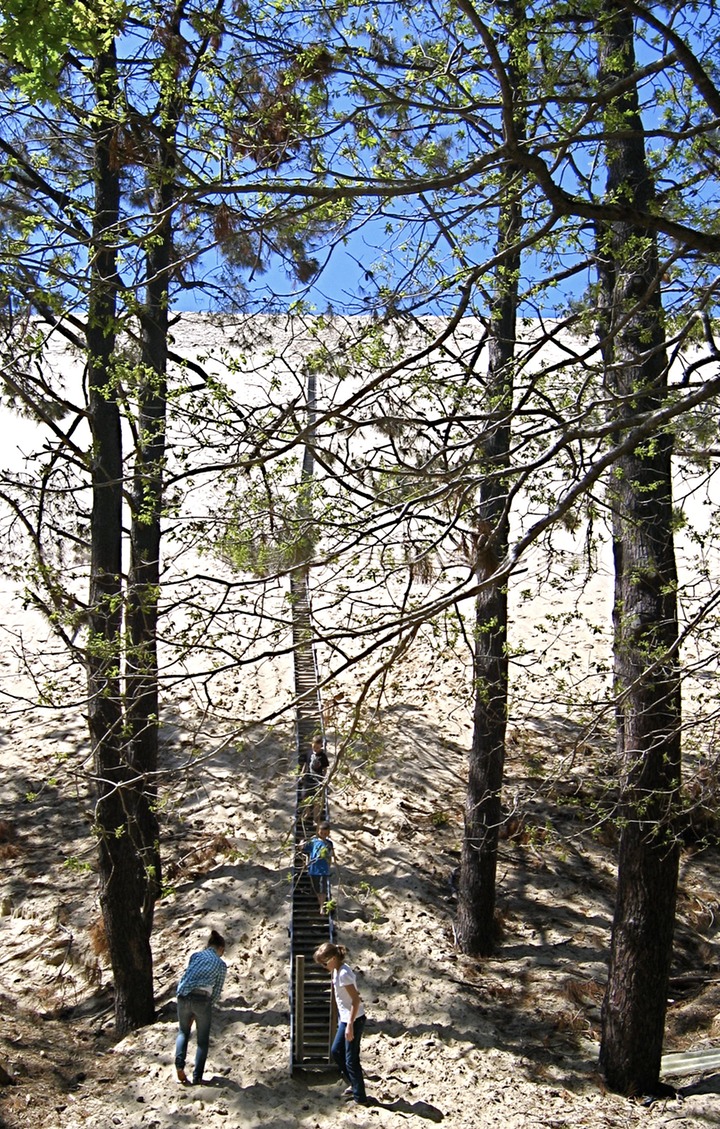
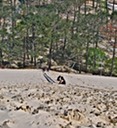
Dune steps . . . . . . But they end well before the top.
Arcachon is a natural harbor, and we could see across and over sand bars and oyster beds out to the ocean. We didn’t go down to the ocean as it was a long way down and there were no steps to help us back to the top. Going down proved a whole lot easier: step,slide, step, slide. On Sunday (when everything is closed) we rode our bikes to the end of the dune for another view. It really is an odd sight. It keeps catching our eye when we are outside. Several times one of us has simply said to the other,”There is a big wall of sand over there” (we are nothing if not observant). It doesn’t quite fit in with our view of reality.
There were hurricane force winds here in January, and the campground owner is still traumatized by it. A lot of damage was done to trees and cabins here, and he has pictures of it running on his computer in office. We also saw lots of damage to the forest on the way over here from Bordeaux. The land went from being very hilly to being as flat as Kansas. We are in a forest basin.
NEWS FLASH: after six days of rain, the last two days we have spent by the dune have been bright and sunny and breezy!, so we managed to get some laundry done. The little laundry and mini spin dryer we brought with us have worked out well, except we use the campground laundry to really rinse things well. The spin dryer is worth its weight in gold. Then we hang it on a clothesline to dry like everyone else in spite of the rules against it. To use the washer and dryer here for one load would cost €8 (about $10.80).
David successfully replaced the thermostat on the water heater, so our hot water now actually deserves the name. We do use the campground showers--our nightly outing--to save on water and waste tank space, because not all campgrounds have a waste dump that we can use. The showers are usually hot, and we have almost always found them to be very clean and well kept. But we usually do have to keep pushing a button every twenty seconds or so to keep the water flowing. Recycling and saving water are very big themes everywhere we go.
Tonight we’re having burgers on croissants because the French apparently don’t believe in making hamburger buns, in spite of the obvious popularity of McDonalds.
Entry 6--May 1
It has rained quite a bit every day for the last six days. We spent two nights in Aubusson keeping an eye on a slowly rising--but quickly moving--river fifteen feet from our back door. We made the sloppy walk into the town once to see the tapestry museum and a small workshop there. It was a lovely old town . . . but too miserable to enjoy.
Then we moved on to the prehistoric cave area. The rain stopped long enough for us to tour the Lasceaux II cave paintings. These are copies of the 17,000 year old paintings found by four boys in 1940: the actual cave was closed to visitors in 1962 because the paintings were being damaged by the carbon dioxide and humidity brought by the thousands of visitors who came. So a model of the original was constructed--dug into the hillside--and opened to the public in 1983, a few hundred feet from the original. It is quite a remarkable thing to see. While waiting for the English version of the tour, we spent some time talking to a British couple who recommended visiting St Emilion, a medieval town near Bordeaux, so we added that to our list. First, though, we headed to Les Eyzies, where cave dwellings literally hang over the town. In this part of France one can stay at Cro-Magnon hotels and eat in Cro-Magnon restaurants and, of course, buy little plastic Cro-Magnon men with spears.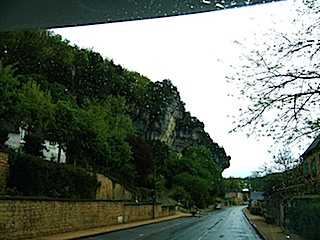
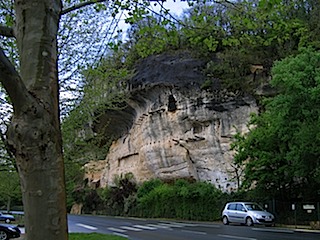
We didn’t do any of those things. Instead, we stayed overnight at a camperstop for €5 in Sarlat-la-Caneda (yet another medieval town), sharing the space with fifteen other motorhomes. Rover attracts a lot of attention in places like that where you are parked side by side in a parking lot.
And then it was on to St Emilion. This is quite an amazing place. It feels like you are in a movie set that cannot quite be real. The town is perched on a hill overlooking thousands of acres of vineyards all around. It was once home to 10,000 but now only 300 people live there. Many of the houses are shuttered and vacant and need repair, which is very difficult and expensive to do because it has been named as one of the top 100 historical sites by UNESCO. The streets are cobbled, steep, and sometimes consist entirely of steps (and, because it had been raining, they’re slippery too). But the most amazing things are underground. We visited St Emilion’s cave (where he lived between 750 and 767!) And we toured the crypts and the entire church that had been carved out of the limestone in the 11th and 12th centuries. There are 50 wine tasting shops tucked into every corner of this magical place, which is also known for its macaroons, here made with almonds instead of coconut. We spent as much at the cookie/chocolate shop as we did for lunch. It really is an amazing place, and I am very glad it was recommended to us. It was well worth the visit.


We stayed at a large campground two miles north of the village. Because of the narrow approaches, we had to go about ten miles out of our way to get there without going through the village. We were briefly stopped by a bike race coming to its conclusion right at the edge of the village and followed a biker through the vineyards to the campgrounds. This sounds simple, but it can be frightening. We knew we couldn’t drive through the town, and as we approached it, already feeling some trepidation, we met a traffic circle with a roadblock set up for the bike race. We know we cannot turn around anywhere: we HAVE to go to the left . . . and, after a momentary stop, the gendarme let us do just that.
This campground has a welcoming committee of six tame geese that approach every single individual as soon as you leave your vehicle, hoping you will be the one who feeds them. They are probably the most photographed geese in France. It was delightful. (This is the foie gras region, and duck is on every restaurant menu . . . which may be why the next morning we were greeted by only four of them.)

And--six days and counting--it is still mostly raining.
Entry 5--April 26
The weather has been beautiful, and we have overdosed on chateaux. We drove only eleven miles to a campground just ouside Cherveny and stayed two nights, where free wifi connections (the first ever), laundry and two bike rides to two chateaux kept us as busy as we wanted to be.


The first was the large Cherverny estate that had been lived in until about fifteen years ago. The most interesting part was the dog kennel with 75+ nearly identical looking, well trained hunting dogs waiting to be fed. The second, at Troussay, was a small family chateau that has been sold only twice since it was built in the 1400’s and still has someone living in the upstairs apartments. We have decided the smaller places are much more livable. The larger ones show only the grand restored rooms--not the kitchens or the servant quarters where the real work was done.

Then it was off to Amboise and one final chateau (final for us, but not for the region--there are more than fifty in the Loire River valley). In addition, though, this town boasts having been the home of Leonardo de Vinci for the last three years of his life. (He was invited by the French king, rather like an aging baseball star who plays out his final years with the Yankees at an inflated salary). He is said to be buried in the tiny Chapelle St-Hubert within the walls of the chateau with the best view of the city and river valley.
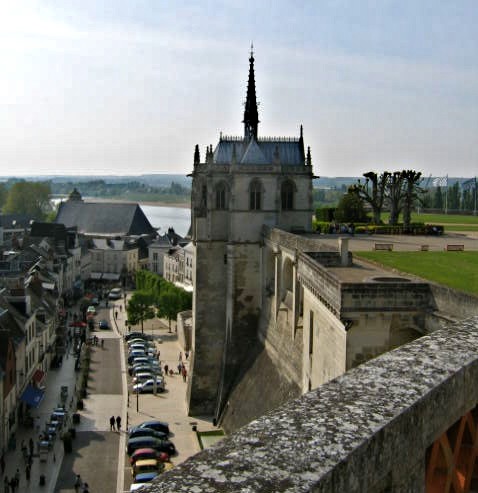

His home, up a narrow steep road from the chateau, is a tourist attraction, made even more special by the creation (thanks to IBM) of working models of machinery that he had drawn but never actually fabricated. It is one fabulous physics and engineering lesson, and the groups of school kids loved it, especially the war tank. We walked through his home: kitchen, studio, even the bedrom where he died in 1519 - 490 years ago. Much of it is still the original. It was very well done. The house is surrounded by large gardens and ponds, and some of the larger “machine” displays were incorporated into the environment there.
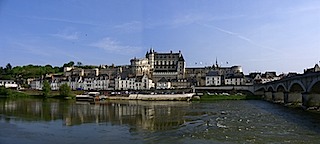
The Chateaux Royal d’Amboise is quite imposing from the river side, but not nearly as ornate as some of the others. Besides the little chapel, it has a unique circular ramp, housed within a turret, wide enough to bring carriages and horses to the upper levels. And one of the huge fireplaces actually had a burning fire in it. We stayed in a campground on an island in the midde of the River Loire, and at night we walked back into the city for an excellent four-course dinner (that’s at least two, sometimes three, more courses than we’re used to). We both had the duck.
We are glad to be here in “low” season. The campgrounds are not crowded, and we do not have to stand in line for anything. The one time I did call ahead to make a reservation I was told, “Oh, just come.” We haven’t bothered calling since. Because we have had our fill of chateaux, we headed south on Friday and put 168 miles on Rover, going to Aubusson, a little town noted for its tapestry museum and workshops. (It was an easy trip: no pedestrians clipped by our mirrors going through narrow village streets, only one 'U-turn: we're going the wrong way,' and two complete circuits of traffic circles while we tried to read the road signs).
We were the only ones in the municipal campground at Aubusson when we arrived but have been joined by two others. And it has started to rain. And the stream that runs through the campground has a flash flood warning sign. And the Twins have lost two to the Red Sox.
On the other hand, yesterday we paid only $5.94/gallon for gas.
Entry 4--April 21
We have been to Chartres and Chambord. Chartres is another old city with a cathedral, but this one is not just yet another in a series--it stands out from the rest. It isn’t the biggest or the tallest, but it might well be the most beautiful, thanks especially to its magnificent stained glass windows. And they have actually been cleaning it! and them! Most of these places haven’t been touched in years and years, but parts of Chartres’s have been thoroughly cleaned and repaired.

We were fortunate to hear part of an organ practice and, later, some of an organ recital; then at night we heard a Swiss choir perform. David said it was funny to hear a French organist playing German Lutheran music (Bach) in a Roman Catholic cathedral.
Besides being a lovely town, Chartres has a great campground about a mile and a half from the old city and cathedral. It’s in a park along a river with a bike path through a wood and the park to the bottom of some very steep hills to the city center. We took our bikes into the city three times, including once returning after dark so we could see the iluminated buildings. It rained on us a bit, but not enough to dampen our spirits. It is a charming place--highly recommended--only a short train ride from Paris.
After two nights in Chartres we drove all of 21 miles to Bonneval on a Sunday, when just about everything was closed. The guide book advised campers not to approach the town from the south, as the streets are too narrow. (You don’t have to warn us about that more than once; nevertheless, even from the north we had to go through some tight spots to get to the campground, and we had to do it again in the morning when we left.) We walked into the town and found the old church open, but with no one else in it. Then we walked around the town a little: only a bar was open. (About the picture below: the sign indicates 3 meters of clearance in height, but the arch is clearly taller than that--3 meters wide, though, I can believe.)

As Americans who have become accustomed to removing shoes and belts before entering even a courthouse, let alone a national monument, we’ve been amazed that these beautiful, ancient buildings are not guarded or secured in any way. No one is checking backpacks or bags; there are people pulling luggage and pushing strollers; we even saw one boy in Amiens Cathedral with a scooter over his shoulder.
It was the same way at Chambord, a huge chateau built by Francois I for a hunting lodge: four floors and towers of stone and carvings and not a guard in sight except at the entrance. It is a very beautiful place that has gone through many restorations. Because it had been abandoned for years and then used for art storage during WWII, most of the rooms were quite empty, but it is a work in progress. An easy access parking lot was provided for buses and motorhomes. It is a popular place.
We then stayed in Blois at a free camping place on the banks of the River Loire (click on the photo below for a larger version). It had no services (no electricity or water, let alone dumping)--just a place to stay for the night. About a dozen motorhomes were parked there with us, and several people, seeing our Minnesota license plates, stopped to ask about Rover and how we got there. Blois (pronounced ‘Blwah’--nearly impossible to say) has such an old city center that some of the streets turn into long flights of stairs. And, of course, it has its own chateau.

I (Susan) have learned the French word for sauerkraut (choucrout) and will not forget it. We went out to dinner in Chartres, and I ordered what turned out to be a huge pile of sauerkraut (like a pile of pasta) with one large peeled boiled potato and five different pieces of meat--sort of: a slice of very good ham, one hot-dog-looking sausage, another kind of sausage, one slice of an even larger and fattier sausage, and one strip of that thick dried uncooked-looking bacon that is eaten in Europe. All in all, a most unappetizing meal. But, c’est la vie, it’s all part of the adventure.
Entry 3--April 17
We drove across more farmland, avoiding the motorways, from Amiens to Rouen. We found an adequate campground with rather shabby facilities a short walk from a frequent tram into the old city center of Rouen. Another huge beautiful cathedral awaited us--this one memorialized in several paintings by Claude Monet under different lighting conditions. It is the middle of the very old city, largely untouched by the wars: lots of narrow pedestrian-only shopping streets. We stayed two nights, visiting the cathedral, an art museum, the square where Joan of Arc was burned at the stake. We got caught in a downpour without our umbrellas and used it as an excuse to eat dinner in a restaurant, and, wonder of wonders, found a portable air compressor that would fit in our outside storage, was big enough to do the job and was affordable, sort of.
We have had quite a time just finding air for the tires. Gas stations are rare in little towns, and even in the cities several we found did not have an air pump. When we left Amiens, we stopped for gas before leaving the city and we were directed to a Citroen garage for air. The first time we had to use an air pump other than our own, we discovered that Europe does not measure air pressure in the psi (pounds per square inch) units that we were used to. That took a whole new calculation that we hoped was correct! But now we have a new compressor and it has psi readings on it also. Success. It was fun getting the big box on to the tram and to the campground. It’s the size of a small suitcase, much larger than what we had before, but much smaller than the tanks everyone else had showed us.
We left Rouen for the short drive to Giverny, home to Claude Monet and his famous gardens and lilypad ponds.

The house he lived in is as it was when he lived there. In his studio was a large picture of him in that very studio; it also showed the same desk and wicker chairs and wall decorations. The house is colorful (a bright yellow dining room and blue and white kitchen) and gorgeous--but the bedroom smelled terribly in spite of the fact that the windows over the garden were wide open. Even this early in spring the gardens were surprisingly full of color. All in all, utterly charming.
Giverny is a very small town that has accepted its fate as a tourst destination. We were delighted to see that they have provided a large parking area, but when we pulled in we were directed back into the center of the village where there is another parking lot. Rover barely made it in and up the hill, taking out a couple of low hanging branches.  We would have been much better off staying in the large lot just off the road. Fortunately we were not there on a very busy day. In fact, most of the people there were Japanese tourists on a bus and many, many five- and six-year-olds with their teachers.
We would have been much better off staying in the large lot just off the road. Fortunately we were not there on a very busy day. In fact, most of the people there were Japanese tourists on a bus and many, many five- and six-year-olds with their teachers.
Then we found our way through one of the tightest roads yet: long blocks with cars parked on one side and nowhere to go if someone came from the other direction. But no one did, and we made it to a scruffy, out of the way campground with mostly old permanently placed camping trailers, very few of them occupied. We had been there about an hour when we saw two policemen walk in and talk to the owner, who pointed toward Rover. (“Voila, them--they’re the reckless American drivers for whom you search.”) They came over to our site and asked us if we had seen anyone on the road when we came in. Surveillance cameras had placed us nearby at the time someone had abandoned a stolen car. We were unable to give them any helpful information. but it confirmed for me that we were in a pretty out of the way place.
We have yet to get ourselves into a too tight spot, but we have managed to get ourselves into a “Centre Ville” when we really didn’t want to go there. Sometimes it is simply unavoidable--there is no other way. If I had a Euro for every time David has asked, “How much room do I have on that side?” I could pay for the campground every night. (He usually has a full 6 or 8 inches to spare!) Yesterday we easily got into a McDonalds parking lot (free wifi) but had to walk all the way across the large shopping center parking lot to figure out how to get out. One of the exits had a 1.9 meter height limit. We are 3.05. We have that memorized.
After our visit to Giverny, we were so inspired by Monet that we created our own Impressionist work, entitled "Still Life: Lilacs, Cheap Wine, and Microwave-Ready Mousaka in RV."

Entry 2--April 13
We have lights; we have running water; we have refrigeration! La vie est bonne! After being told at one repair shop that we would have to wait for days to be seen, the place in Oostende asked, “In 35 minutes?” It took more than an hour of nervous waiting and then only another 45 minutes before Rover reappeared. “A loose wire from the battery box” was the € 67 explanation. Everything works again. And, as if in expiation for last year’s misbehavior, the hot water heater has actually turned itself back on when the water in it gets used up! We were off to the nearest grocery, ATM, LP gas pump, and campground, exhausted but greatly relieved.
That was Friday; on Saturday morning we drove down the coast to Calais--through a busy tourist area that shows no sign of a slowing economy--this being the first holiday weekend of the season. From Calais we headed inland toward the Paris-Roubaix bike race route and found a little village campground 3 km from the route.
 I was delighted to also see a little church just down the street, but when I inquired about Easter services I was told there would be none. “Just one priest for 17 parishes. He was here last Thursday and will be here again sometime in May.” So on Easter Sunday we got up to ride our bikes to the race route and found a chocolate rooster on one bike seat, compliments of the campground proprietor. We waited for the race in front of another silent village church. Around 11 a.m. about a dozen primary school children and their parents gathered for a short egg/candy hunt on the well kept lawn. Some traditions never end. A small crowd gathered, the hundreds of support vehices from the race came by, the bikers flew past,
I was delighted to also see a little church just down the street, but when I inquired about Easter services I was told there would be none. “Just one priest for 17 parishes. He was here last Thursday and will be here again sometime in May.” So on Easter Sunday we got up to ride our bikes to the race route and found a chocolate rooster on one bike seat, compliments of the campground proprietor. We waited for the race in front of another silent village church. Around 11 a.m. about a dozen primary school children and their parents gathered for a short egg/candy hunt on the well kept lawn. Some traditions never end. A small crowd gathered, the hundreds of support vehices from the race came by, the bikers flew past, 
 and we rode our bikes back to the campground. Later we went to the only open functioning business in the village: a sports bar--so named because it has a big tv--and watched the finish of the race. Tom Boonan won, going away.
and we rode our bikes back to the campground. Later we went to the only open functioning business in the village: a sports bar--so named because it has a big tv--and watched the finish of the race. Tom Boonan won, going away.
Then on to Amiens and the largest cathedral in France. Easter Monday turns out to be a holiday for most people. We have been trying to find an open gas station with an air pump to fill the bike tires and doublecheck Rover’s. And we are still in the hunt for an air compressor that will fit in the motorhome. We did finally find a huge grocery store and, now that we are trusting our refrigeration, bought about as much as we can fit in our cupboards and refrigerator. And then we stumbled upon a campground about three miles from the center of the city with the help of an old French lady who was very excited to help us. (Like many Americans, she seemed to think that the more often and more emphatically she repeated her directions, the more likely we were to understand her. And, like many Americans, she was wrong.) We rode our bikes back along the Somme to the city center and the cathedral and even ate at an outdoor Greek restaurant.
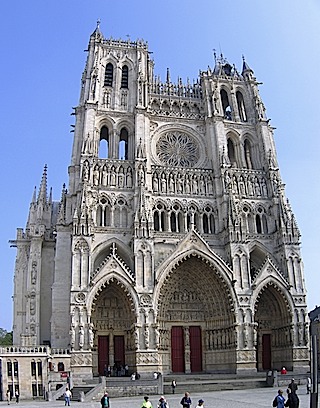
We have come into Spring. Trees and flowers are budding and blooming everywhere. We are surrounded by fifty shades of green. We drove through forty miles of already worked farm fields this morning that reminded us of southern Minnesota--big rolling fields with few hedges or forest breaks. We don’t think of this kind of place when we think of France, but this is definitely big farm country and it is beautiful. This is the Somme region, so the countryside is also dotted with military cemeteries from WWI: each one full of flowers and well trimmed lawns, and even 90+ years later some freshly placed remembrances. 
Entry 1--April 10
Herewith, the beginning of Tour de Rover 2009.
As with any complex undertaking, one expects that not everything will go perfectly. Amidst the joys, there will be a few cloudy days, here and there one will feel a bump in the road, occasionally the happy traveler experiences a hiccup or two along the way....
But before this sucker was two days old, it had developed into a full-fledged, all-out, spatter-on-the-walls, barf-session. (Spoiler alert at the end of this entry.)
We left for Amsterdam in the evening of April 6 on a half-empty aircraft with a screaming two-year-old (not ours, thank you very much). Our plane landed at 10:30 a.m., and because our three pieces of luggage were among the first six off the plane and because there was no line at customs (does nobody want to visit Amsterdam in the spring?), we were at the storage place and greeting Rover by noon. The few maintenance jobs had been completed, and Rover had even had a bath. Everything looked great--for the moment. And by 2 p.m. we were in the campground just south of the city with a few groceries and a full tank of water.
Our first job was to unpack and de-winterize. Both pieces of our new “laundry” (hand-crank washer and spin dryer) had arrived intact in spite of the Transportation and Safety Administration’s attempt to Save America by unpacking and repacking the spin dryer. First glitch: By night we noticed our water tank was almost empty and discovered that the drain valve had never been closed after we had drained it for winterizing. In the process of discovering this, Susan inadvertently shut off the entire water supply and we thought that the water pump had quit. It took us a day to figure all of this out, of course, but thanks to our two big water storage bags, we got along without the pump or refilling.
One of David’s first jobs was to recheck all the tires’ pressure. Soon after he had begun, the air compressor quit working (as in “burned out”). We spent the second day in the city center of Amsterdam, in the wind and rain (so that’s why nobody wants to visit Amsterdam in the spring!). Needless to say, air compressors are hard to find in the tourist section of Amsterdam. We actually found a couple on the way back to the campground, but David deemed them insufficient.
The following morning brought a bigger problem. We had no 12-volt service to the motorhome: no lights, no refrigerator, no water pump, no water heater. (All these things did work when the engine was running, with the engine battery providing the service--but not when it was off. As of course it usually is in a campground.)
All the simple things we have tried have failed, and we have even talked to the service people at Born Free in Iowa. Right now we are in line at a large camping repair store in Oostende, Belgium, hoping our problem can be solved in hours rather than days. Our phrase from last year--“It’s all part of the adventure”--isn’t quite working for us right now. In fact, the next one one of us who uses it gets punched.
(SPOILER:
ings-thay o-day et-gay etter-bay.)
4/10/09
